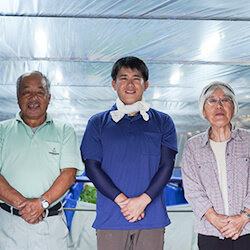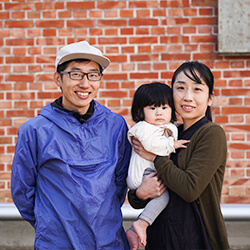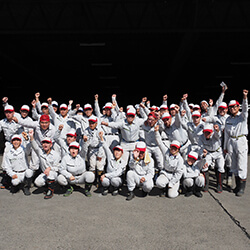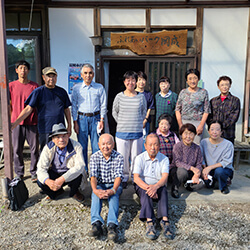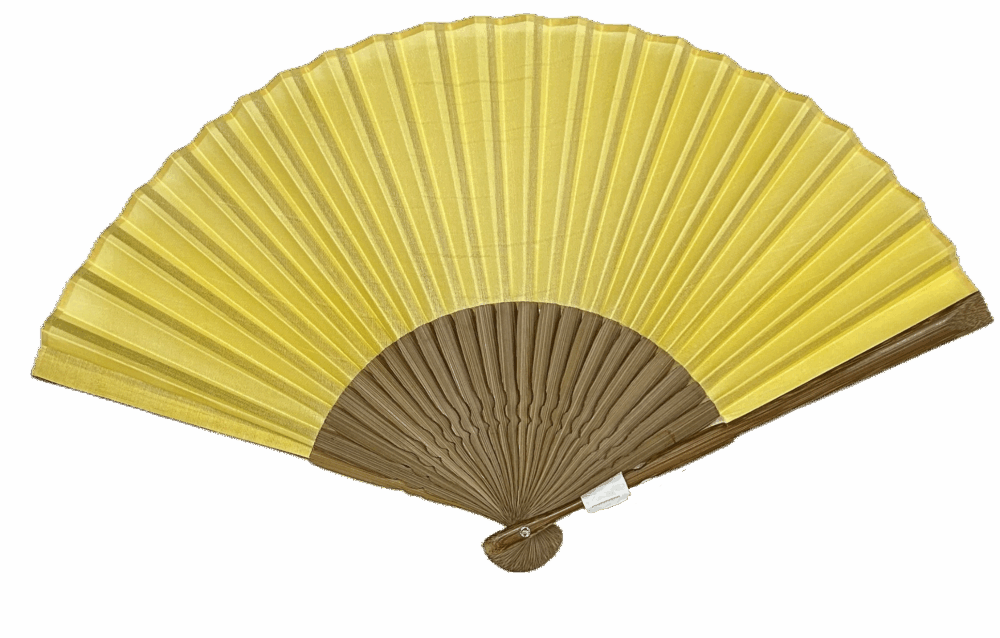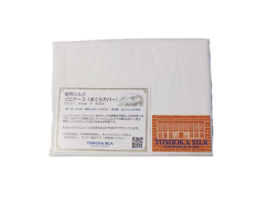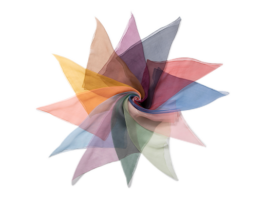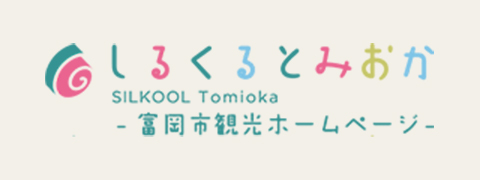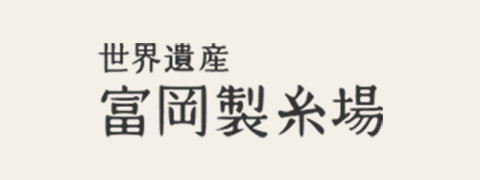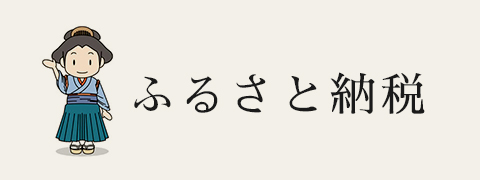


Tomioka silk
100% made in Japan
Tomioka silk
Less than 1%* of the silk
sold in Japan is produced entirely in Japan.
In Japan, a product made with imported raw silk can bear the mention "made in Japan" on the condition that it has been transformed in Japan.
Silk products made from Japanese cocoons processed on the territory represent less than 1% of the items on sale.
Tomioka silk is 100% made in the city of Tomioka.
Nevertheless, the rarity of our products alone does not make them valuable.
They are carefully made by passionate and trusted professionals. The consumer will thus be able to have access to exemplary traceability.
Tomioka silk brand favors authentic and valuable products, rather than mass production.
*Figure from the Japanese Silk Association
The history
of Tomioka silk
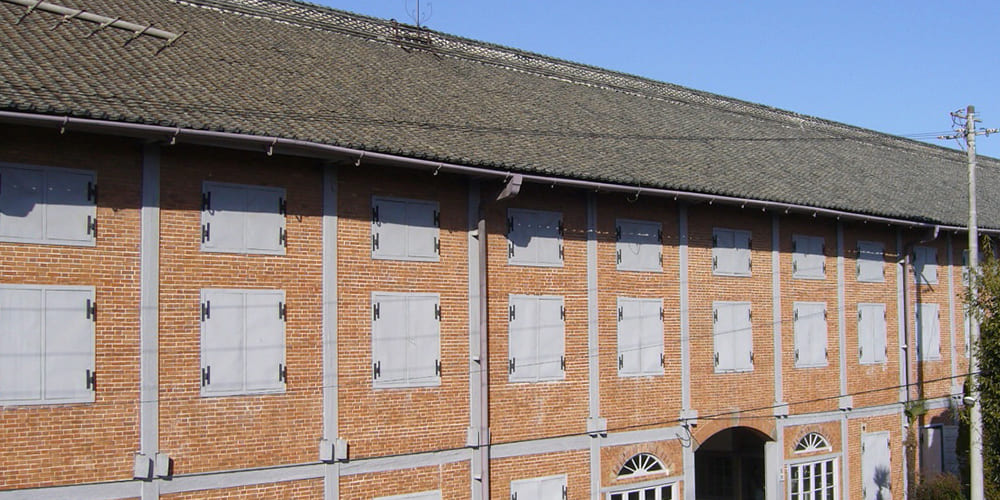
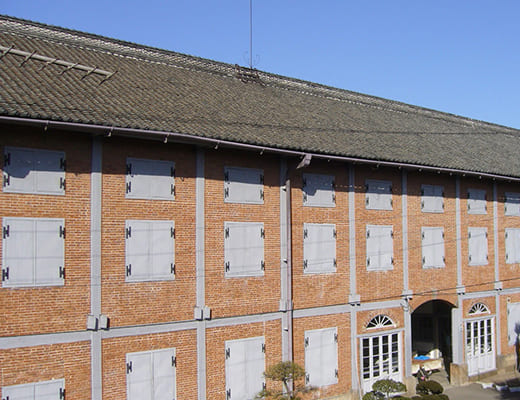
Tomioka's pride through the centuries
As the sericulture industry continues to decline, the registration of the Tomioka silk mill as a UNESCO World Heritage Site has led to the emergence of young enthusiasts eager to pass on the culture of Tomioka silk. A new generation, inheriting technologies and techniques that have supported the Japanese silk industry, and the pride of their ancestors, is taking up the torch.
Tomioka's pride through the centuries
As the sericulture industry continues to decline, the registration of the Tomioka silk mill as a UNESCO World Heritage Site has led to the emergence of young enthusiasts eager to pass on the culture of Tomioka silk. A new generation, inheriting technologies and techniques that have supported the Japanese silk industry, and the pride of their ancestors, is taking up the torch.
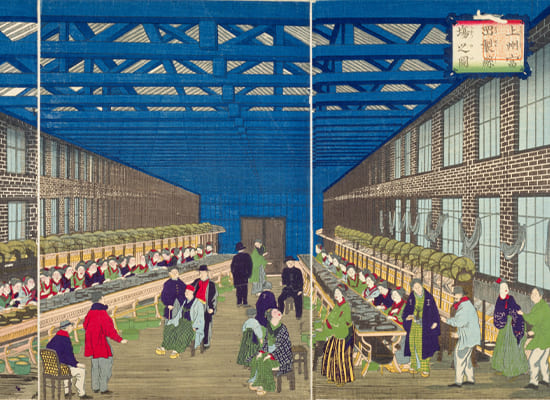
Gunma, the starting point of “made in Japan” products
During the Meiji period (1868-1912), Tomioka silk mill led the Japanese silk industry to the highest level in the world. At the 1873 World's Fair in Vienna, Tomioka silk won the 2nd "progress prize", becoming one of the finest silks in the world. In 1909, Japan became the world's leading exporter of raw silk by conducting research on reeling techniques as well as on sericulture, allowing a stable supply of high quality raw silk. Made-in-Japan silk was exported to the world and quickly won the hearts of consumers. It was at this time that silk, a product once reserved for a privileged class, became accessible to a greater number of consumers around the world.
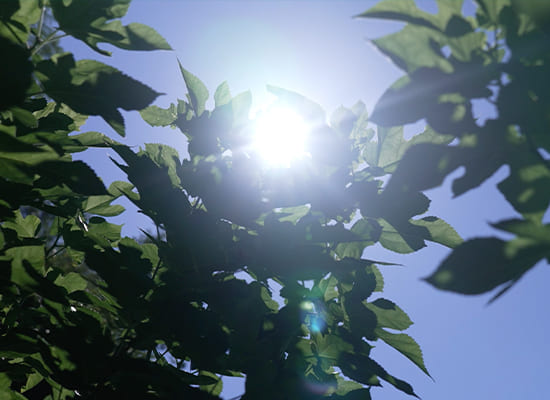
Sericulture thrives thanks to a rich nature.
One of the reasons given for the construction of the Tomioka silk mill in Tomioka is the presence of a flourishing sericulture for centuries. Indeed, the city is rich in its draining soils facilitating the cultivation of high quality mulberry trees, in a temperate climate favorable for sericulture, and in farmers who love silkworms. In recent years, many young enthusiasts have moved to Tomioka to take up the torch after learning sericulture techniques from experienced farmers. Supported by a rich nature and the enthusiasm of the locals, the culture of silk continues to thrive in Tomioka.
A completely transparent manufacturing process
Where were silkworms born?
What did they eat?
Who raised them and how?
How did the cocoons become silk?
The whole making process of Tomioka silk is transparent.
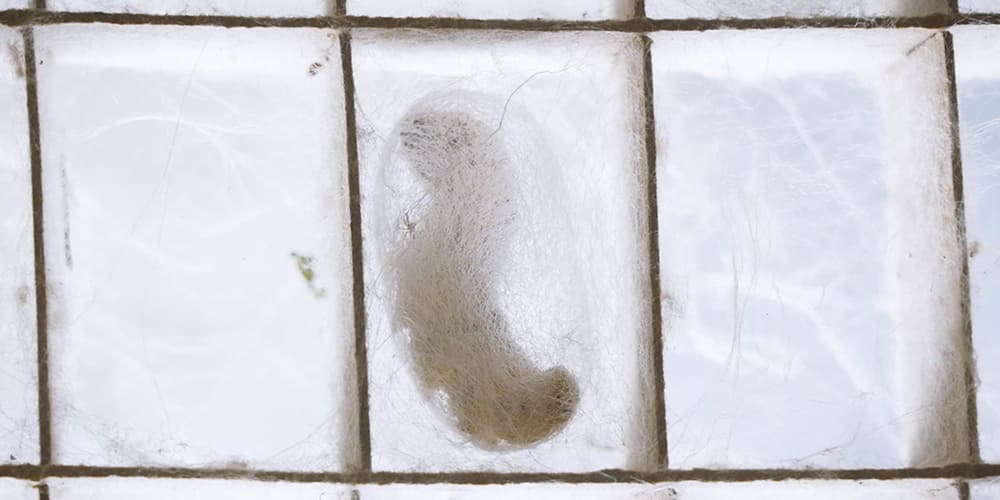
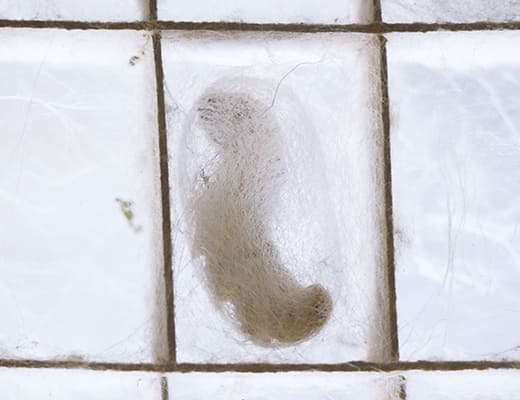
Newly hatched silkworm larvae measure only 2 mm. Being prone to diseases, they are bred in specialized breeding centers implementing a strict health protocol, then are sent to farms after their second moult.
Silkworms, also known as celestial worms (see Japanese characters meaning), only eat mulberry leaves. They eat very large quantities of it during the 3rd, 4th and 5th instar in order to grow.The sound of this feast by a large number of worms is often compared to the sound of rain. Sericulture farmers can cut mulberry leaves up to 5 times a day to satiate the worms.
When they stop eating and their bodies turn yellow and translucent, they are ready to make their cocoon. They are then placed on a "kaiten mabushi" (rotary cocooning frame) on which they weave, for 2 days, a cocoon to protect them during their metamorphosis. The length of the thread of one cocoon varies from 1,300 m to 1,500 m. When the larva metamorphoses into a pupa, the cocoon is removed from the cocooning frame and sold.
Sericulture is a constant challenge. The temperature control, the amount of food and the date of cocoon production differ each time.
The breeding of silkworms requires daily vigilance for farmers who raise them with affection.
From hatching eggs
to selling cocoons
Newly hatched silkworm larvae measure only 2 mm. Being prone to diseases, they are bred in specialized breeding centers implementing a strict health protocol, then are sent to farms after their second moult.
Silkworms, also known as celestial worms (see Japanese characters meaning), only eat mulberry leaves.
They eat very large quantities of it during the 3rd, 4th and 5th instar in order to grow. The sound of this feast by a large number of worms is often compared to the sound of rain. Sericulture farmers can cut mulberry leaves up to 5 times a day to satiate the worms.When they stop eating and their bodies turn yellow and translucent, they are ready to make their cocoon. They are then placed on a "kaiten mabushi" (rotary cocooning frame) on which they weave, for 2 days, a cocoon to protect them during their metamorphosis. The length of the thread of one cocoon varies from 1,300 m to 1,500 m. When the larva metamorphoses into a pupa, the cocoon is removed from the cocooning frame and sold.
Sericulture is a constant challenge. The temperature control, the amount of food and the date of cocoon production differ each time.
The breeding of silkworms requires daily vigilance for farmers who raise them with affection.
A silk that reflects the efforts made
Silkworms cannot survive without human intervention. Silk farmers who often call them “oko-sama” (“beloved silkworms”) raise them like their own children. Before sunrise, and then several times during the day, they go to the fields to cut fresh mulberry leaves for their meals. To avoid the development of diseases, they ensure the hygiene of the farms and meticulously control the temperature. Silkworms raised with affection and benevolence make the most beautiful silk threads.
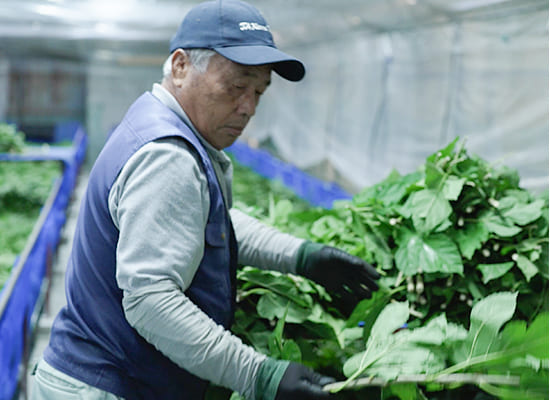
Gunma, land of silk: original seeds created for the climate of Gunma
Although only one generic term is used, there are many varieties of silkworms: fine-thread worms, Japanese summer-hardy worms, yellow-thread worms , worms that make yarn in large quantities, etc. Tomioka silk is made with original Gunma seeds, developed to adapt to the climate of the prefecture. We thus offer inimitable products with special characteristics. The fact that there are still so many varieties of silkworms today is proof of the advanced sericulture techniques of Gunma, the land of silk.
 GUNMA
GUNMA
HOSO GUNMA
GUNMA
200 GUNMA
GUNMA
-KOGANE NATSUKO
NATSUKO SANTA
SANTA JOSHU-
JOSHU-
KENBOSHI SHINKO
SHINKO
ISHIMARU SHIN-
SHIN-
SEIHAKU SEIKI21
SEIKI21
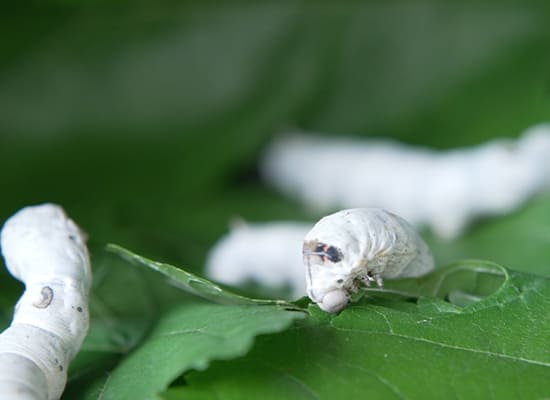
"GUNMAHOSO", an exceptional seed grown in some rare silkworm farms.
The "GUNMAHOSO" is an exceptional seed cultivated by only a few breeders from Tomioka and Annaka, which even among the original seeds of the prefecture, gives cocoons with extra-fine yarn. With a thickness of only 2.2 deniers, the thread unwound from the cocoons is 30% finer than an ordinary silk thread. It is suitable for dyeing, has an immaculate white and a brilliant luster worthy of the finest silks. All of our original products are 100% made with "GUNMAHOSO" seeds.
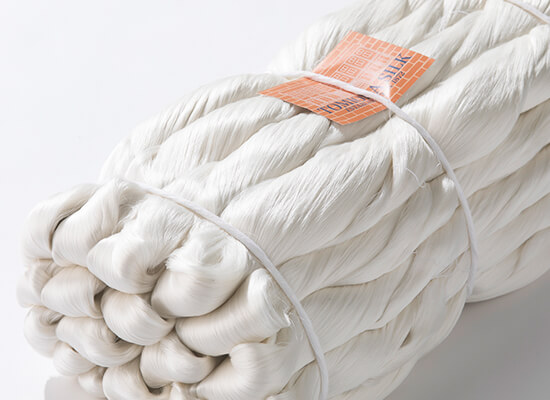
From the sale of cocoons to the
production
of raw silk

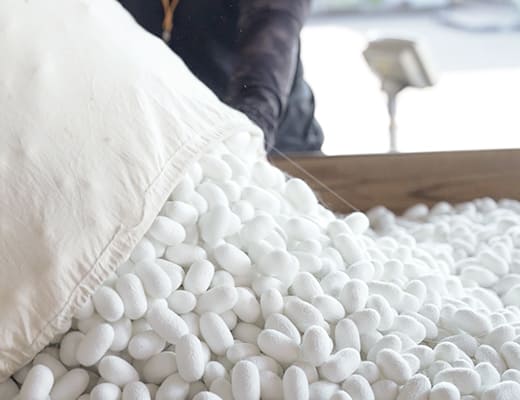
Cocoons produced by sericulture farmers are processed into raw silk at the largest silk mill still in operation in Japan, Usui silk mill, located in the city of Annaka. Arrived at the factory, they are dried in hot air before being stored so that the pupae inside do not turn into butterflies. The cocoons are then boiled to soften the filaments and unwound on automatic reeling machines. The silk filaments are about 1/4 of the thickness of a human hair. Several filaments are therefore twisted to form a single thread of raw silk. As our original products are unwound on state-of-the-art type 6A reeling machines, if a knot forms, causing uneven dyeing, it is automatically detected. The staff then unties the knot and quickly ties the threads together. The combination of advanced technologies and experienced workers gives birth to a soft and uniformly fine raw silk.
Cocoons produced by sericulture farmers are processed into raw silk at the largest silk mill still in operation in Japan, Usui silk mill, located in the city of Annaka. Arrived at the factory, they are dried in hot air before being stored so that the pupae inside do not turn into butterflies. The cocoons are then boiled to soften the filaments and unwound on automatic reeling machines. The silk filaments are about 1/4 of the thickness of a human hair. Several filaments are therefore twisted to form a single thread of raw silk. As our original products are unwound on state-of-the-art type 6A reeling machines, if a knot forms, causing uneven dyeing, it is automatically detected. The staff then unties the knot and quickly ties the threads together. The combination of advanced technologies and experienced workers gives birth to a soft and uniformly fine raw silk.
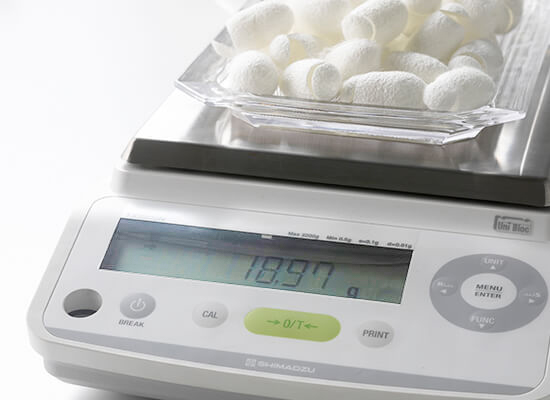
Rigorous quality control according to our standards
A cocoon emptied of its pupa weighs about 1g
The difference in quality is estimated to within 0.01g
All cocoons produced in Tomioka are delivered to the Tomioka silk promotion organization. They undergo rigorous quality control according to the standards of the organization. Stained or irregular cocoons are eliminated, and weight measurements are made to the nearest 0.01g. Since the weight of silk obtained from a single cocoon is significant, sericulture producers producing high-quality cocoons are highly valued. Time-consuming checks reinforce the motivation of farmers and contribute to improving the quality of the cocoons.
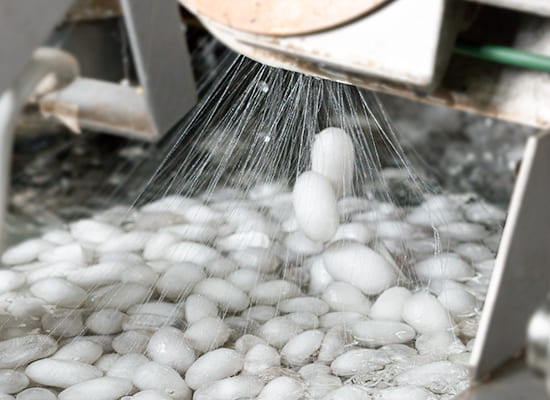
“NAMABIKI” silk, a unique silk, the result of territorial cooperation
Cocoons produced in Tomioka are processed into raw silk at the Usui silk mill, located in the nearby town of Annaka. On order, we produce "NAMABIKI" silk from cocoons freshly harvested and not subjected to hot air drying. A production made possible thanks to strong cooperation and a relationship of trust between the various players. The "NAMABIKI" raw silk, made from spring cocoons, considered to be the most qualitative cocoons of the year, is extremely rare, and has a unique beauty with an unequaled luster and excellent color rendering.
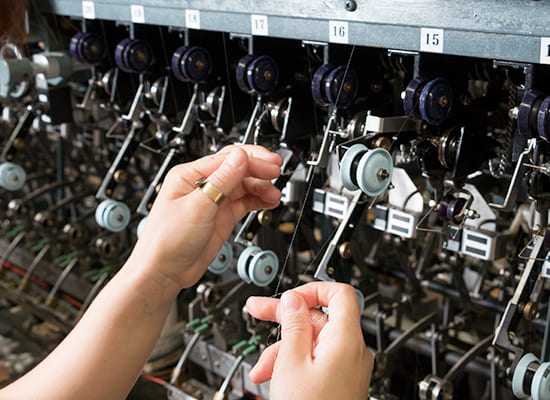
Usui silk mill, producer of nearly 70% of Japanese silk and owner of state-of-the-art reeling machines
Usui silk mill is one of the last two operating silk mills in Japan. With a strong attachment to made-in-Japan products, the company only transforms cocoons produced in Japan. Of all the machines in the factory, Tomioka silk is unwound on the world's best, type 6A reeling machines. The combination of high-precision machines and experienced workers gives birth to a soft raw silk with an incomparable luster. Thanks to a process specific to the factory, no antiseptics such as formalin being used, the silk is so pure that it can be used for baby underwears.
Tomioka (Gunma), the cradle of silk.
Experience Tomioka silk,
produced in a rich nature by passionate farmers.
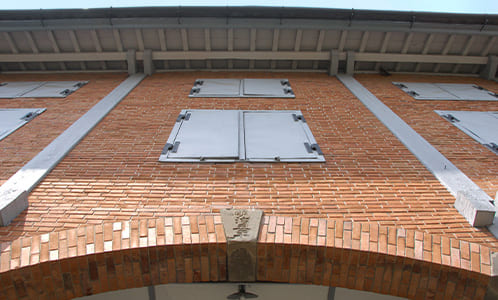
Tomioka silk
promotion organization
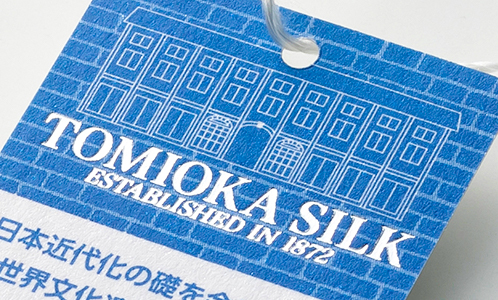
Tomioka silk brand
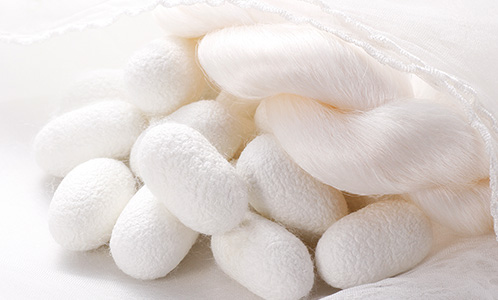
Q&A about silk
関連商品のご紹介
オンラインショップTOPへOur shops
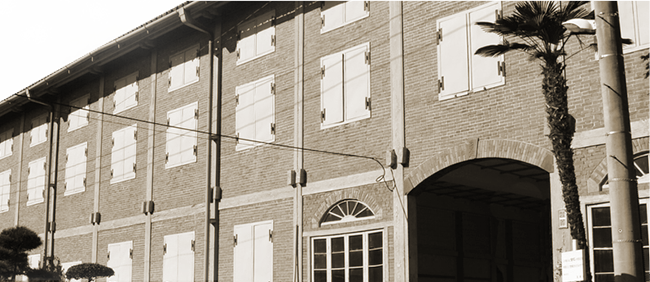
"Silk Gallery" in Tomioka
The products of the Tomioka silk brand are on sale in the "Silk Gallery" within Tomioka silk mill.
(South area of the East cocoon warehouse)
We will be delighted to welcome you during your visit in Tomioka silk mill.

- Opening hours
-
Hours:9:00 a.m.〜4:45 p.m.
Closing days:see closing days of Tomioka silk mill
*We may temporarily close
or shorten opening hours in the event
of unforeseen events.Address:33-4 Tomioka, Tomioka-shi
370-2316 Gunma, JapanPhone:0274-67-0075





